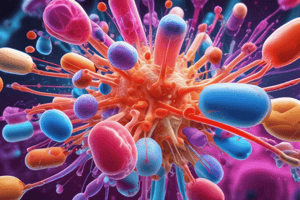Podcast
Questions and Answers
What is meant by selective toxicity in relation to antibiotics?
What is meant by selective toxicity in relation to antibiotics?
- Binding easily to human cells
- Causing minimal harm to the host organism
- Disrupting a structure or process essential for microorganism growth and survival (correct)
- Causing harm to the host organism
Why must antibiotics cause minimal harm to the host organism?
Why must antibiotics cause minimal harm to the host organism?
- To cause disruption to a structure essential for microorganism growth and survival
- To ensure they are therapeutic but not excessively toxic (correct)
- To avoid binding easily to human cells
- To increase their effectiveness against microorganisms
Which of the following is an essential requirement for antibiotics according to the text?
Which of the following is an essential requirement for antibiotics according to the text?
- Causing minimal harm to the host organism
- Binding easily to human cells
- Causing disruption to a structure essential for microorganism growth and survival (correct)
- Causing disruption to a structure not essential for microorganism growth and survival
Why is it important for some antibiotics to have a narrow therapeutic index?
Why is it important for some antibiotics to have a narrow therapeutic index?
Which scenario represents selective toxicity in antibiotics?
Which scenario represents selective toxicity in antibiotics?
What does therapeutic drug monitoring aim to achieve for some antibiotics?
What does therapeutic drug monitoring aim to achieve for some antibiotics?
Which structure/process is disrupted by cell wall active agents in bacteria?
Which structure/process is disrupted by cell wall active agents in bacteria?
What is the mode of action of b-lactam antibiotics in bacteria?
What is the mode of action of b-lactam antibiotics in bacteria?
Which type of bacteria can produce enzymes that destroy the b-lactam ring of antibiotics?
Which type of bacteria can produce enzymes that destroy the b-lactam ring of antibiotics?
What is the primary target of glycopeptides like vancomycin in bacteria?
What is the primary target of glycopeptides like vancomycin in bacteria?
Which enzyme is inhibited by b-lactam antibiotics in bacteria?
Which enzyme is inhibited by b-lactam antibiotics in bacteria?
What is the consequence of disrupting the process of peptidoglycan synthesis in bacterial cell walls?
What is the consequence of disrupting the process of peptidoglycan synthesis in bacterial cell walls?
Which type of bacteria are affected by glycopeptides like vancomycin?
Which type of bacteria are affected by glycopeptides like vancomycin?
What is the role of b-lactamase inhibitors in the presence of b-lactam antibiotics?
What is the role of b-lactamase inhibitors in the presence of b-lactam antibiotics?
'Transpeptidases' are enzymes involved in the:
'Transpeptidases' are enzymes involved in the:
What is the primary target of glycopeptides like vancomycin in bacterial cells?
What is the primary target of glycopeptides like vancomycin in bacterial cells?




